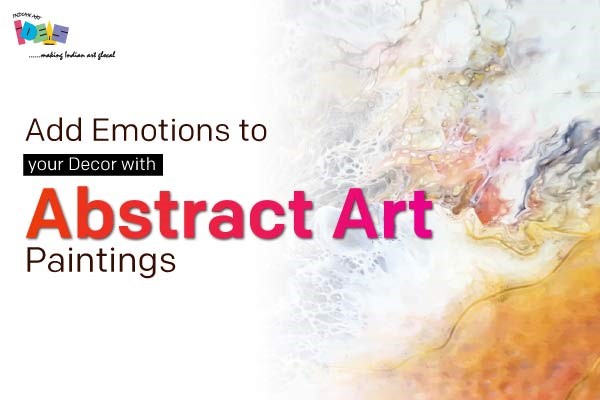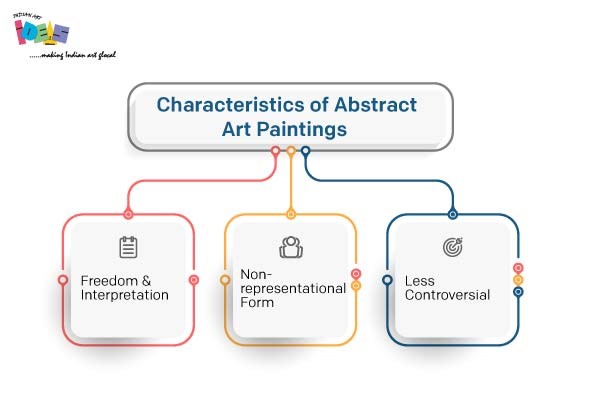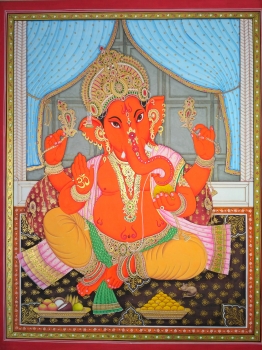
Be it a living room, dining room, bedroom, or any kind of interior, having a flavor of bright color always makes it stand out and look vibrant. From basic wallpaper to stylist ceramic tile, the choice of options to enhance interior decor is infinite. As the real estate industry is on a continuous boom, a lot of interior designers are emerging in the market who are offering top-notch decorative ideas for minimal, luxury, classic, and other decor themes. As of now, there are endless options for enhancing your home decor but one of the most budget-friendly and suitable options is wall paintings.
Paintings not only enhance your walls' appearance but also make them stand out from the rest of the walls. There is absolutely no doubt that paintings have played a key role in enhancing home decor and enhancing the charm and elegance. Abstract art is one of the most common types of artwork that is getting recognition from various artists and buyers in comparison to other traditional paintings.
Understanding Abstract Art
Abstract art is generally taken to mean a piece of artwork that doesn't define a particular genre, theme, or category but rather focuses on patterns and shapes that don't belong to any category. The distancing of an idea from the subject is the overall theme of abstraction and nonrepresentational art. In contrast to traditional modes of representation, abstract art focuses on completely random shapes, colors, textures, and lines to transmit feelings, ideas, and impressions rather than presenting recognizable objects or scenarios. It is an intriguing and diverse genre. The literal depiction of reality is abandoned, and viewers are encouraged to interact with the artwork more viscerally and imaginatively.
History of Abstract Art
The history of abstract art can be traced back to the early 20th century which witnesses a revolution questioning the traditional art form. With the help of this movement, artists got the incredible opportunity to experiment with different colors, shades, styles, shapes, and patterns that exhibited a different style of art. Wassily Kandinsky, a Russian painter and art theorist, was one of the first pioneers of abstract art. Kandinsky created theories about abstract art at the beginning of the 20th century and argued that art should exhibit emotions exclusively through the use of color, form, and line instead of recognizable objects.
Many artists began to create art that didn't always refer to things in the real world at the turn of the 20th century, defying formal teachings. This new style of painting was referred to as "pure art" because the subjects were entirely original to the artists and not copies or references from the outside world. Abstract artists experimented with new methods like using vibrant yet arbitrary colors, reconstructing shapes, and rejecting realistic three-dimensional perspectives, emphasizing an artwork's formal qualities over its representational subject matter.
Understanding the Characteristics of Abstract Art Paintings

They offer freedom and interpretation
The flexibility it gives the artist to explore with arbitrary shapes, styles, colors, textures, and lines is one of abstract art's most remarkable qualities. Without being concerned about the limitations of reality, artists are free to freely paint their own ideas onto a canvas. This freedom allows artists to craft masterpieces that not only stand out from the traditional paintings but also speak for themselves. For viewers, abstract painting can have its own meaning and interpretation since abstract painting does not relate to any specific object of reality. Multiple viewers can relate to these paintings in their own way.
Their form is non-representational
Traditional art represents a recognizable form, scene, objects, and shapes that can be easily recognized and understood by the viewer as traditional art paintings have a definite meaning. They represent a particular thing that is not subjective and has a meaning that is common to viewers, However, in the case of abstract art paintings, there is no specific meaning associated with reality or any specific things. These paintings' use of forms, colors, textures, and lines is entirely arbitrary and does not directly reflect any one thing. Thus, the non-representational nature of abstract art works is one of their key qualities.
They are less controversial
Many instances have occurred in the past where traditional paintings have created numerous controversies. The lack of emotional connection between the artist and the viewer is one of the key causes of this. The conventional artwork need not be viewed by the audience in the same way that the artist intended. Having a difference of opinions for paintings that depict religion, caste or any other social aspect is extremely common. Abstract paintings on the other hand are just random use of shapes, styles, colors, and objects that do not represent any social aspect of reality. Since they do not have any specific meaning, viewers are free to have their own views about it without any controversy arising.
Read More: Impact of Abstract Art Paintings from Pixels to Emotions
Abstract Art Paintings in Home Decor
In terms of interior design, abstract art paintings may completely change a room by bringing life, originality, and energy into it. There are several ways abstract art can improve interior design:
Expressive Colors and Moods: With vibrant colors on the palette, abstract art painting can set the theme or mood of the room. Be it in the shade of blue, green, or red, abstract art paintings balance the interior decor scheme and personalize it as per your taste.
Versatility in Placement: Abstract art paintings are highly versatile in terms of their placement and can be placed anywhere. Be it a living room, dining space, hallway, or office, abstract art seamlessly blends with the interior and enhances the overall aesthetics.
Personalized Aesthetic: Each work of abstract art is distinct from the others and capable of many interpretations. This makes it possible for people to choose items that speak to them personally and reflect their style, personality, and taste. It exhibits the person's distinctive aesthetic and has a significant visual effect.
 Conclusion
Conclusion
Abstract art is a powerful illustration of how innovative and creative humans can be since it deviates from traditional depictions and places a strong emphasis on emotion, form, and color. The world beyond its outward appearance can be seen via the lens of abstract art, which also enables us to explore the depths of our feelings and emotions. Abstract paintings' widespread acceptability and recognition will help us understand and appreciate art better in the future, inspiring and captivating new generations. Be it minimal home decor or luxurious, adding abstract art paintings will surely make your walls look lively and stand out.
Interesting Blog: Discovering the Different Styles of Abstract Art Paintings
FAQs
Q1 What is the key to abstract art paintings?
Answer: In contrast to other artistic movements, abstract art has a very strong sense of self. The distinctive voice of abstract art piques interest and gives both creators and viewers a sense of freedom and expression. Although it frequently appears chaotic and unplanned, it actually has a structure made up of six fundamental components: color, shape, form, texture, line, and value. Each component is essential to any work of art, but without consideration and deliberate thought, it is easy to overlook them. When properly balanced, the six elements' distinctive qualities combine to produce an engaging work of art. Although they are the essential elements, the artist ultimately decides whether and how to use them. All are significant, but some receive more attention than others. Artists are frequently advised to concentrate on each component separately while taking note of what it will contribute to the artwork as a whole.
Q2 What is the essence of Abstract Art?
Answer: Painting, sculpture, or graphic works of abstract art, also known as nonobjective or nonrepresentational art, play little to no role in depicting objects from the outside world. Form, color, line, tone, and texture are all examples of what is referred to as abstract art elements. These abstract elements were used by artists before the 20th century to describe, illustrate, or recreate the world of nature and human civilization, with exposition taking precedence over expressive function.
Q3 Who is the founder of abstract art?
Answer: Russian artist Wassily Kandinsky was renowned for his original ideas and artistic theories. He thought of the artist as a prophet and of art as a spiritual vehicle. The first known and documented European artist to produce wholly abstract art was Kandinsky. This would alter the course of modern art and create new opportunities for the long term. In the year 1866, Wassily Kandinsky was born in Moscow, Russia. His ancestry is technically both European and Asian even though he is renowned as a great Russian painter. His grandmother was a Mongolian princess, his father was a Serbian Kyakvita, and his mother was a Muscovite Russian.





















